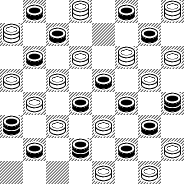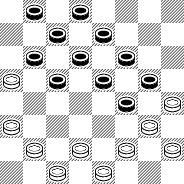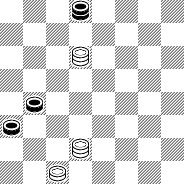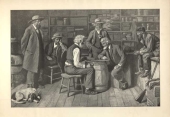The Checker Maven
The World's Most Widely Read Checkers and Draughts Publication
Bob Newell, Editor-in-Chief
Published each Saturday morning in Honolulu, Hawai`i
Contests in Progress:
Two Easy Pieces

This excellent book of tactics is extremely difficult to find at any price. Yet, it is such a valuable reference and training book for beginner and intermediate alike, that The Checker Maven has decided to produce, over a period of months, a freely available electronic version. (Recall that we did the same with Arthur Reisman's fine book of basics, Checkers the Easy Way, available in Postscript and PDF formats.) The copyright is long expired, and there are no legal or ethical barriers to republication.
We'll present a few pages in The Maven every few weeks, as mood and opportunity catches us; and we'll simultaneously gather it all together in what will eventually become a newly-typeset printable book.
Let's start off, then, with a pair of problems from the introductory pages of the book. We've called them Two Easy Pieces, and though these are speed-solvers for the experienced player, they present important basic concepts for the learner to master. Willie's own entertaining commentary accompanies each problem.
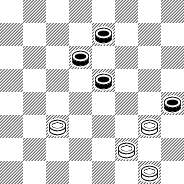
White to Play and Win
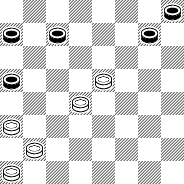
White to Play and Win
When you've given these a good try, click on Read More for the solutions.
[Read More]Remarkable, Indeed
In January we presented a mind-boggler of a stroke problem (click here to see it again). This month, we offer another brain-twister of a different nature. Take a look at the situation diagrammed below, titled Remarkable Block Problem and attributed to an author calling himself "X.Y.Z."
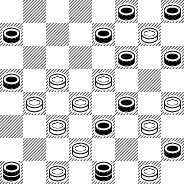
WHITE
White to Move and Win
It all reminds us of Crowther's original Adventure game in which "you're in a maze of twisty passages..." But that was "XYZZY", not "X.Y.Z."
And, by the way, did you try to get your computer to solve this one? It's doubtful that any computer program would be able to come up with the solution. Click on Read More for some supplementary discussion on why this might be.
[Read More]Who Was That Masked Man?
1. Solve the problem (of course).
2. Identify the person in the photo (on the left), who is the problem's compositor. You can click on the photo for a full-size version.
February's entry will be what will probably turn out to be the easiest of the three, at least in terms of identifying the person in the photo; we're not so sure about the problem itself! Here it is:
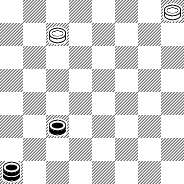
BLACK
Black to Play and Win
Are You Faster Than the World Champion?

Can you beat the World Champion? The clock is ticking!
(The Maven thanks Brian Hinkle for sending this one along.)
Now click here to see the animated solution. Did you beat the Champion? Record your results here.
The Little Fooler
The feature problem for February is entitled The Little Fooler and is credited to Tom Wiswell and Jimmy Ricca. No less an authority than Ben Boland himself called this "a fine original problem." Skilled solver Brian Hinkle took almost a month to crack it.
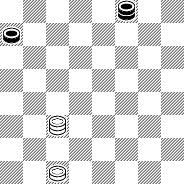
WHITE
White to Play and Win
Give this gem a really good try; your efforts will be well rewarded. After you've tried it, vote on how hard you thought it was, and click on Read More for the elegant solution.
[Read More]Speed Department

How quickly can you solve these? A timer is running while you work! Click "Got It!" when you've figured it out and you'll see exactly how long it took.
Click Read More to check your solution.
These problems are provided courtesy of a gentleman named Charles, who in 2005 is celebrating his 60th year playing the Grand Old Game. He can be found on the GoldToken game site under the name NATONE. Look him up and play a friendly game or two.
Now: ready, get set, GO!
No. 1 (easy)
No. 2 (very easy)
[Read More]But the Computer Says......
Here's a problem attributed to O. H. Richmond, and published a little over 50 years back by Tom Wiswell. He called it "Black Beauty":
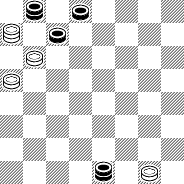
WHITE
Black to Play and Win
Now, you'll surely find that this is a neat problem and a "real twister" as Wiswell would say. So solve it, check your solution with the animation here, and then click on Read More to find out what the computer has to say about this problem. It won't be what you think--- or will it?
[Read More]A Real Mind-Boggler
The Checker Maven presents as its most unusual offering for January the following mind-boggler attributed to a Mr. W. Veal. It is a "stroke" problem, that brand of spectacular, if unrealistic fireworks that appeals to some and is anathema to others.
To be sure, the position below is composed and obviously impossible; there just aren't that many pieces in a game, and they could never get into such a contorted distribution. But for the fan of the stroke problem, realism isn't the issue. The whole point is a clever key move or two, and lots of action afterwards.
Now, depending on what computer program you use, you may or may not be able to coax it into solving this for you. But you really should try it on your own. And since the play is mostly all forced, the challenge is more in trying to visualize the moves than it is in actually finding the solution. But the visualization challenge is mind-boggling indeed. Can you make it out or will this just drive you over the edge?
Position Beats Possession
The title of this problem is a saying of Tom Wiswell's, and when you find (or see) the solution, you'll understand the wisdom of it. The position arose in a handicap game that Mr. Wiswell played something like 50 years ago.
You might find this one a little difficult unless you're used to solving a certain type of problem (but if I told you what type I might be giving away too much). Good luck! When you've solved it, click here for an animated solution.
Coffee and Cake

"This problem has been dubbed by experts the champion 'coffee and cake' problem. This means that you can set this problem up for your friends and bet them coffee and cake that they cannot win it."
I bet Brian Hinkle coffee and cake, and not surprisingly, I now owe him! But can you win it? Give it a good try and then treat yourself to coffee and cake no matter the outcome.
You can view an animated solution here. Did you win coffee and cake?
The Checker Maven is produced at editorial offices in Honolulu, Hawai`i, as a completely non-commercial public service from which no profit is obtained or sought. Original material is Copyright © 2004-2025 Avi Gobbler Publishing. Other material is the property of the respective owners. Information presented on this site is offered as-is, at no cost, and bears no express or implied warranty as to accuracy or usability. You agree that you use such information entirely at your own risk. No liabilities of any kind under any legal theory whatsoever are accepted. The Checker Maven is dedicated to the memory of Mr. Bob Newell, Sr.

